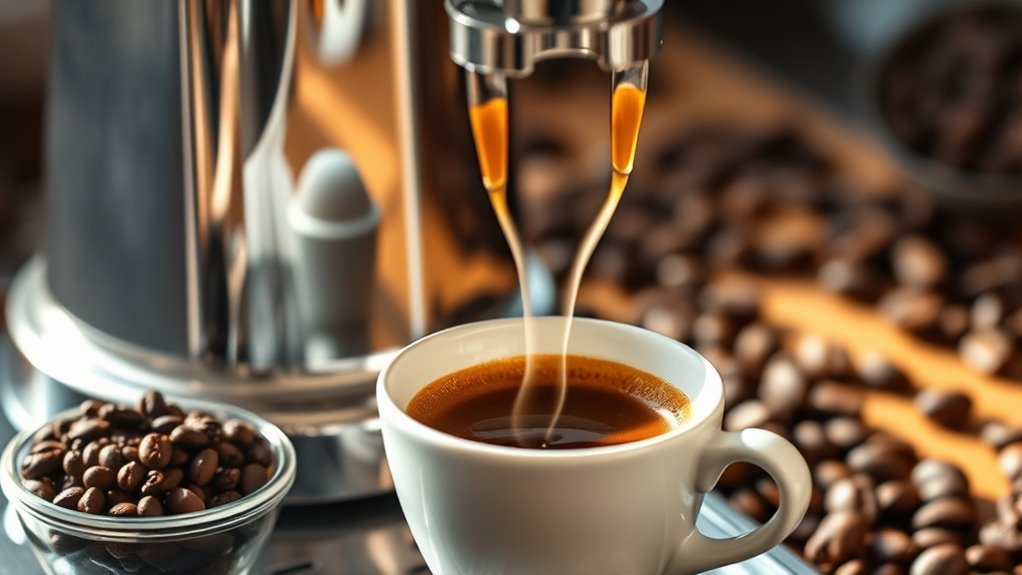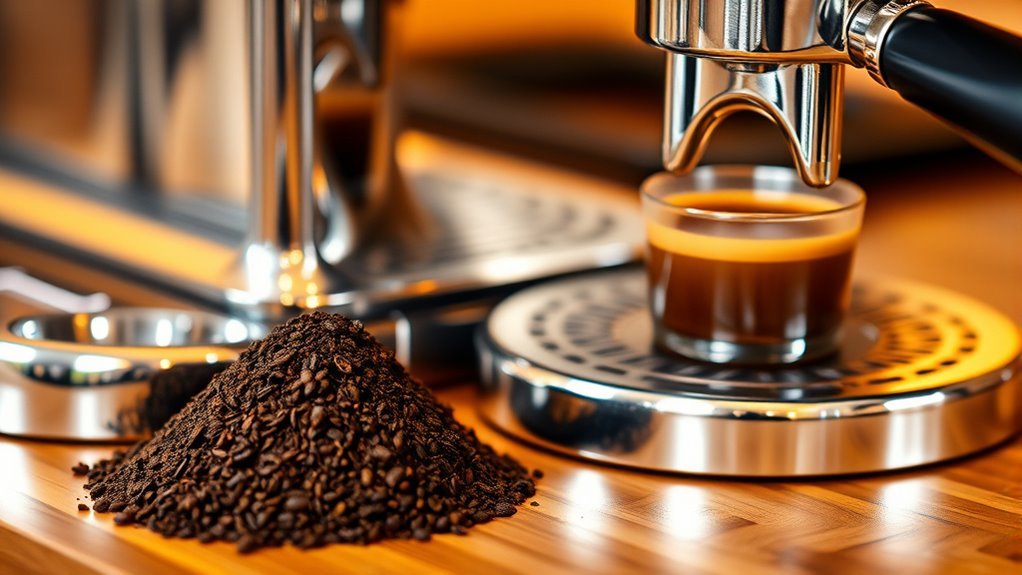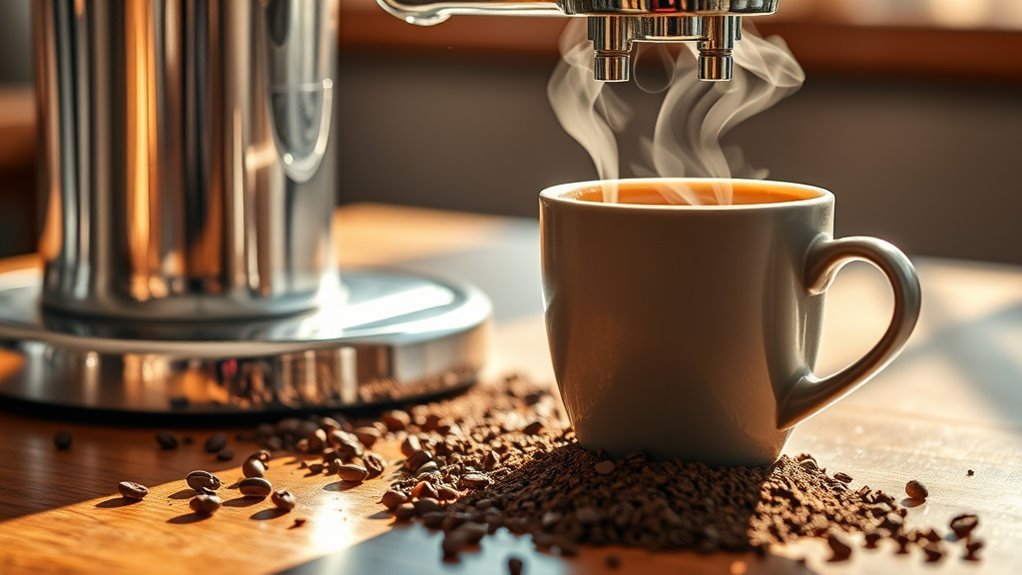Can You Use Regular Coffee Grounds in an Espresso Maker
Using regular coffee grounds in an espresso maker isn’t ideal. Their coarse texture hinders proper extraction, which requires fine grounds for best flavor and rich crema. The intense pressure intended for espresso can lead to under-extraction when faced with unevenly sized particles. This may result in a flat and unbalanced brew, lacking intricate nuances. If you want to explore ways to make the most of your coffee, there are effective methods to enhance your brewing experience.
Understanding Espresso and Its Unique Requirements

When you explore the world of espresso, it’s essential to recognize that this beloved beverage isn’t just about brewing coffee; it’s a complex art form that demands precision and care. Understanding espresso extraction starts with its unique pressure requirements. Typically, you’ll need around 9 bars of pressure to achieve that rich, syrupy shot you crave. This intense pressure forces water through finely ground coffee, extracting crucial oils and flavors that create the espresso’s signature taste. If you use regular coffee grounds, you risk uneven extraction, leading to a lackluster and bitter brew. Mastering the nuances of grind size, tamping, and pressure is critical, allowing you to fully appreciate the freedom and joy that a perfectly pulled shot can bring to your day.
The Difference Between Regular Coffee Grounds and Espresso Grounds
When you compare regular coffee grounds to espresso grounds, the grind size is an essential factor that can’t be overlooked. Espresso requires a fine grind to create that rich, concentrated flavor and creamy crema, while regular grounds are coarser and designed for different brewing methods. This difference in grind directly impacts the flavor profile, resulting in a bold, intense shot of espresso versus a milder cup of regular coffee.
Grind Size Comparison
Although you might be tempted to use regular coffee grounds in your espresso maker, understanding the critical differences in grind size is essential for achieving the perfect shot. Espresso requires a fine grind consistency, allowing for ideal extraction during the short brewing time. Regular coffee grounds are coarser, leading to uneven extraction and a diluted flavor. With espresso, the extraction time is typically between 25 to 30 seconds; if the grind size isn’t right, you could end up with a bitter or sour shot. The precise grind not only enhances flavor but also creates that rich crema atop your espresso. So, if you crave that café-style experience, invest in a quality grinder to reveal your coffee’s full potential.
Flavor Profile Differences
While you might think coffee is just coffee, the flavor profiles of regular coffee grounds and espresso grounds reveal a world of difference that can elevate your brewing experience. Espresso grounds are typically roasted darker and ground finer, achieving a remarkable flavor intensity that packs a punch in every sip. This concentrated brew emphasizes bold notes, often producing a rich crema that encapsulates the essence of coffee. In contrast, regular coffee grounds tend to offer a more balanced taste, with milder flavors that can sometimes lack the depth you crave. When using espresso grounds, you’ll notice a pronounced taste balance, enhancing your overall enjoyment. Embracing these differences can lead to a newfound appreciation for the art of brewing.
Potential Flavor Impacts of Using Regular Grounds

Using regular coffee grounds in an espresso maker can greatly alter the flavor profile of your brew, as the grind size and extraction process play essential roles in the final taste. When you use coarser grounds, you might lose the intricate flavor nuances that finely ground coffee delivers. This can lead to a flat or unbalanced brew, masking the rich aroma variations that accompany a true espresso experience. The pressure and temperature of the espresso machine are designed for fine grounds, so using regular ones can result in under-extraction, leaving you with a cup that lacks depth. If you’re passionate about coffee, embracing the right grind size is important to revealing the full spectrum of flavors and aromas that espresso can offer.
Brewing Efficiency: Coarse vs. Fine Grounds
When comparing brewing efficiency between coarse and fine coffee grounds, it’s vital to understand how grind size influences extraction time and flavor outcome. Fine grounds allow for quicker extraction, resulting in rich, concentrated flavors, ideal for espresso. However, they can also lead to over-extraction if you’re not careful, which might yield bitter notes. Coarse grounds, on the other hand, require longer brewing times, often resulting in a lighter flavor profile. For best results, you’ll need to experiment with grind adjustments based on your preferred brewing techniques. If you crave the freedom to explore diverse flavor profiles, mastering grind sizes becomes essential. With each adjustment, you’re not just brewing coffee; you’re crafting an experience.
Tips for Using Regular Coffee Grounds in an Espresso Maker

Although many espresso enthusiasts swear by finely ground coffee, incorporating regular coffee grounds into your espresso maker can yield surprisingly delightful results if approached with care. To get started, experiment with slightly coarser grounds while maintaining a balance between flavor and extraction time. Pay close attention to your espresso preparation techniques; aim for a brew time of around 25-30 seconds for best results. Use a higher coffee-to-water ratio to enhance the richness of your brew. Remember, the key to great coffee extraction is consistency, so make small adjustments as needed. Finally, don’t hesitate to play with water temperature—slightly cooler water can help extract nuanced flavors. Embrace your freedom to explore and enjoy the unique taste of your espresso!
Alternative Methods for Brewing Espresso-Like Coffee
If you’re seeking a rich, espresso-like experience without an espresso machine, several alternative brewing methods can deliver that intense flavor profile you crave. Consider using a Moka pot, which forces water through coffee grounds under pressure, mimicking espresso’s brew strength and depth. Aim for a fine grind and adjust your extraction time to achieve that robust flavor. Another option is the Aeropress; with its unique design, you can control your brew strength by playing with steeping times and pressure. You can also try the French press, though it won’t replicate espresso perfectly, it offers a strong, full-bodied coffee. Experiment with these methods, and you’ll be well on your way to satisfying your espresso-like cravings without the machine.
Frequently Asked Questions
Can I Mix Regular Coffee Grounds With Espresso Grounds?
Mixing grounds can be a fun experiment to explore new flavors. If you’re looking for a unique flavor balance, combining regular coffee grounds with espresso grounds might just do the trick. The espresso’s rich, concentrated taste can complement the lighter notes of regular coffee, resulting in a robust cup. Just keep in mind that the grind size and extraction time will vary, so adjust your brewing method accordingly for the best results. Enjoy the freedom to create!
How Does Grind Size Affect Espresso Extraction Time?
Imagine your espresso machine as a race car, where every detail matters! Grind size isn’t just a minor detail; it’s the turbocharger for extraction efficiency. Finer grounds lead to quicker extraction, while coarser ones slow it down. You’ll want that perfect grind consistency to maximize flavor and aroma. If you’re off, your espresso could end up bitter or weak. So, fine-tune your grind, and let your passion for coffee freedom shine!
Will Using Regular Grounds Damage My Espresso Machine?
Using regular coffee grounds in your espresso machine can indeed impact its performance. The grind size is essential for espresso extraction, and coarser grounds might clog the system, leading to potential damage. For ideal espresso machine care, stick to fine grounds designed for espresso. By doing so, you guarantee a rich flavor while preserving your machine’s longevity. Embrace the freedom of crafting perfect shots, but respect the technical demands of your equipment!
Can I Use Flavored Coffee Grounds for Espresso?
You can definitely use flavored coffee grounds for your espresso, but be mindful of how it affects the espresso taste. The added flavors can enhance or overpower the natural characteristics of the coffee. When using flavored grounds, opt for high-quality beans to guarantee a balanced extraction. Just remember that the oils and additives might clog your machine over time. Embrace the freedom to experiment, but keep maintenance in mind for ideal results!
What Is the Ideal Brewing Temperature for Espresso?
Brewing espresso is like dancing with precision—every step matters. The ideal extraction temperature for espresso sits between 195°F and 205°F. At this range, you’re harnessing the power of espresso brewing techniques to reveal rich flavors and aromatic oils. Too hot, and you’ll scorch the beans; too cool, and you’ll drown in sour notes. Mastering this temperature gives you the freedom to create a perfect shot, elevating your coffee experience to new heights.






